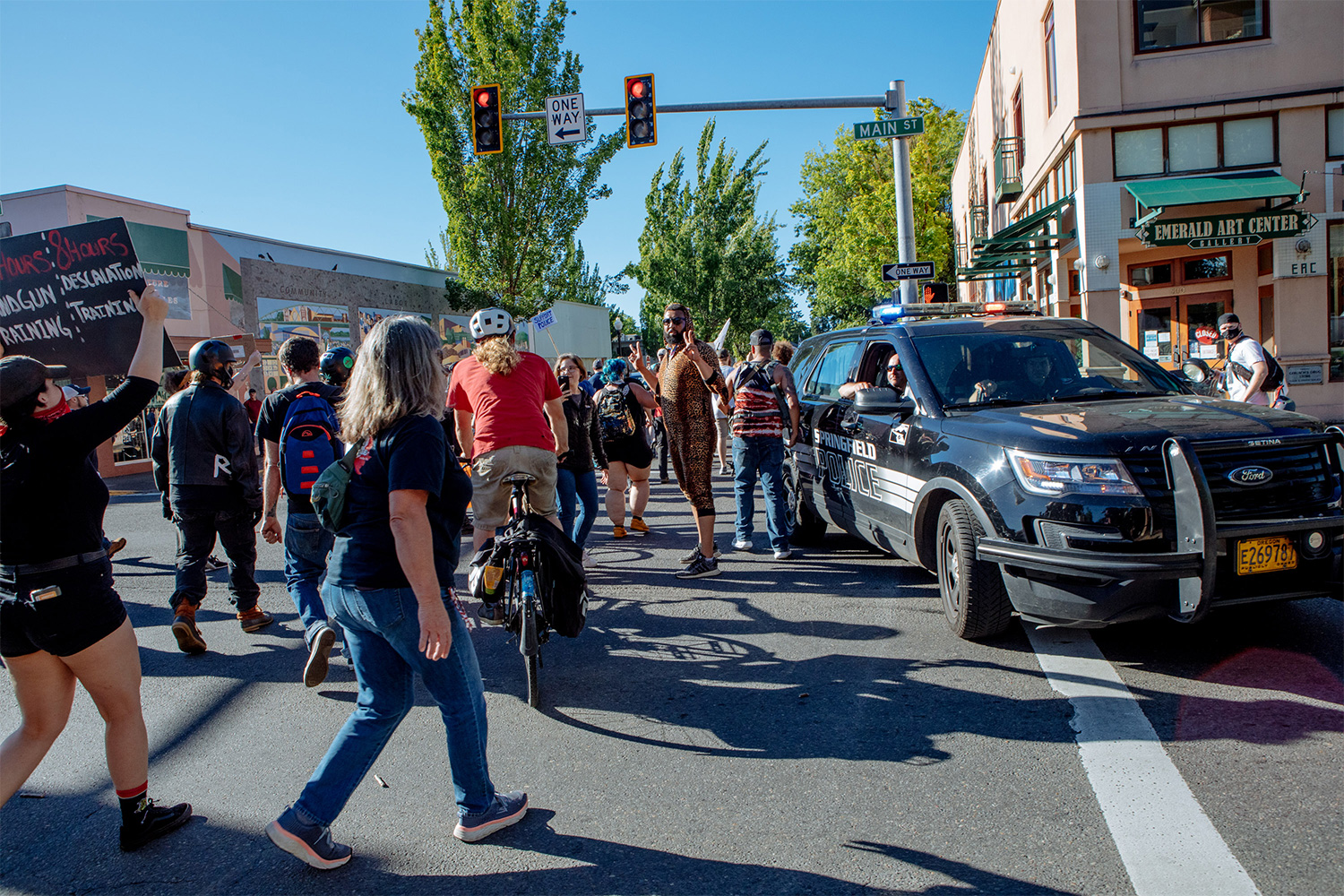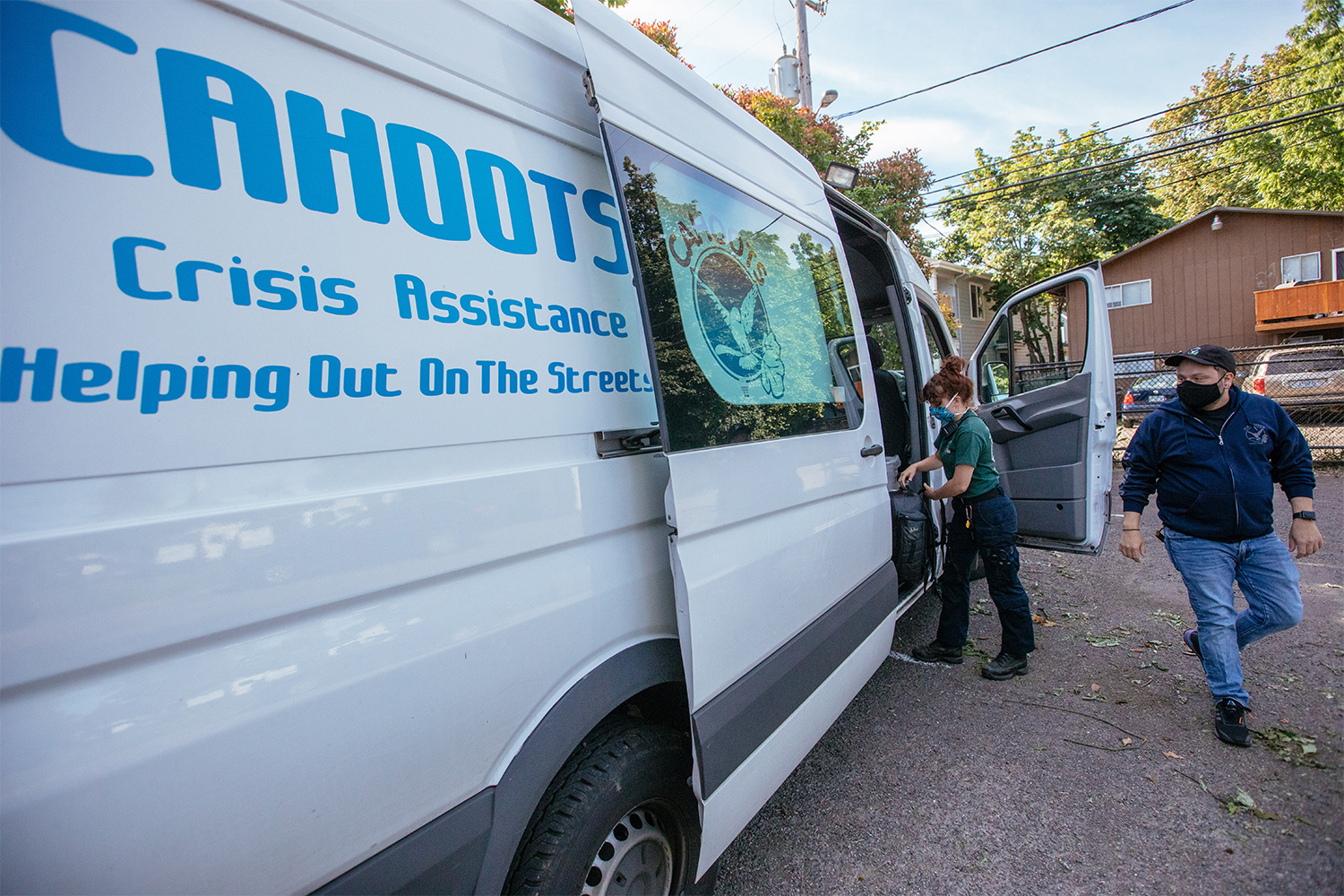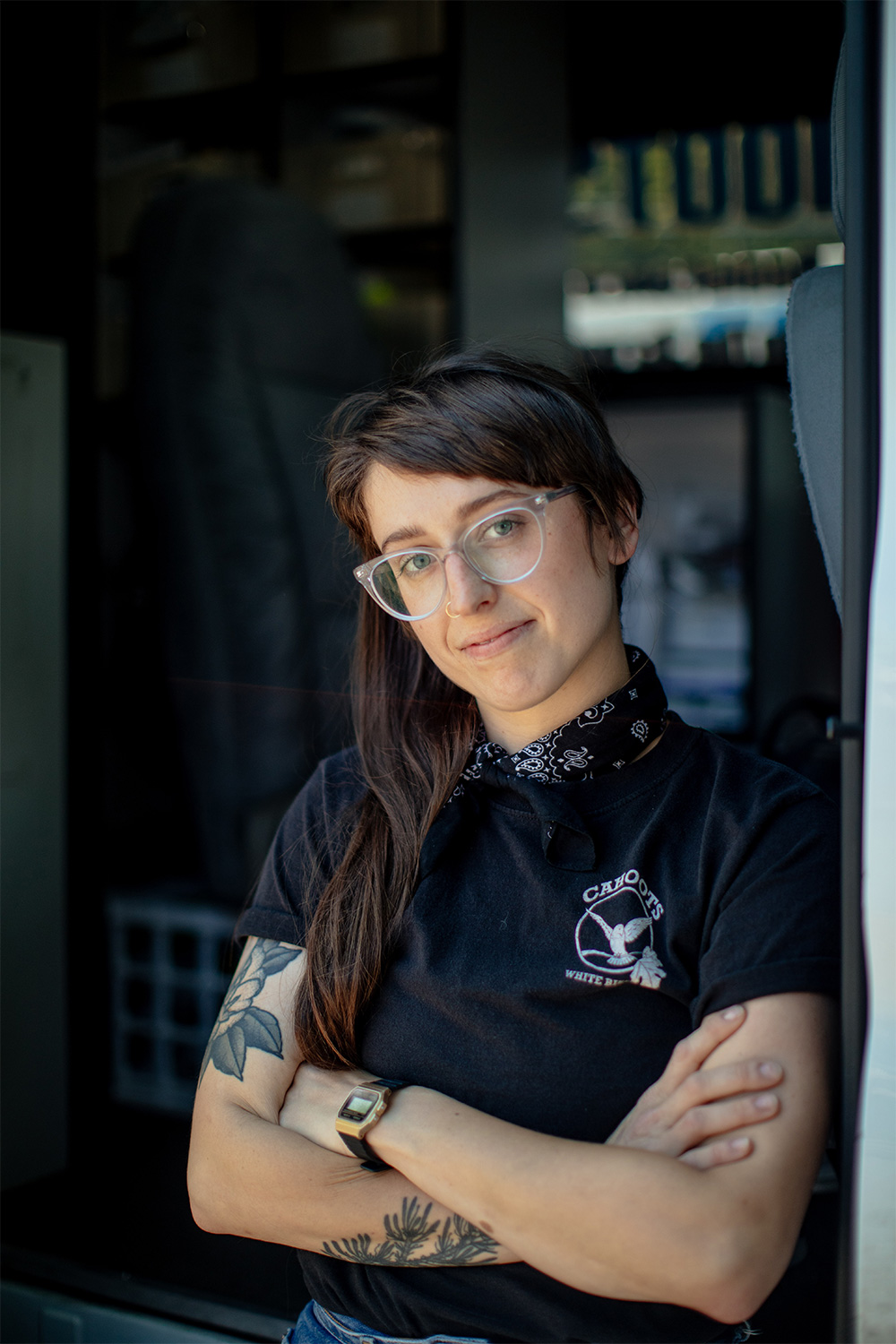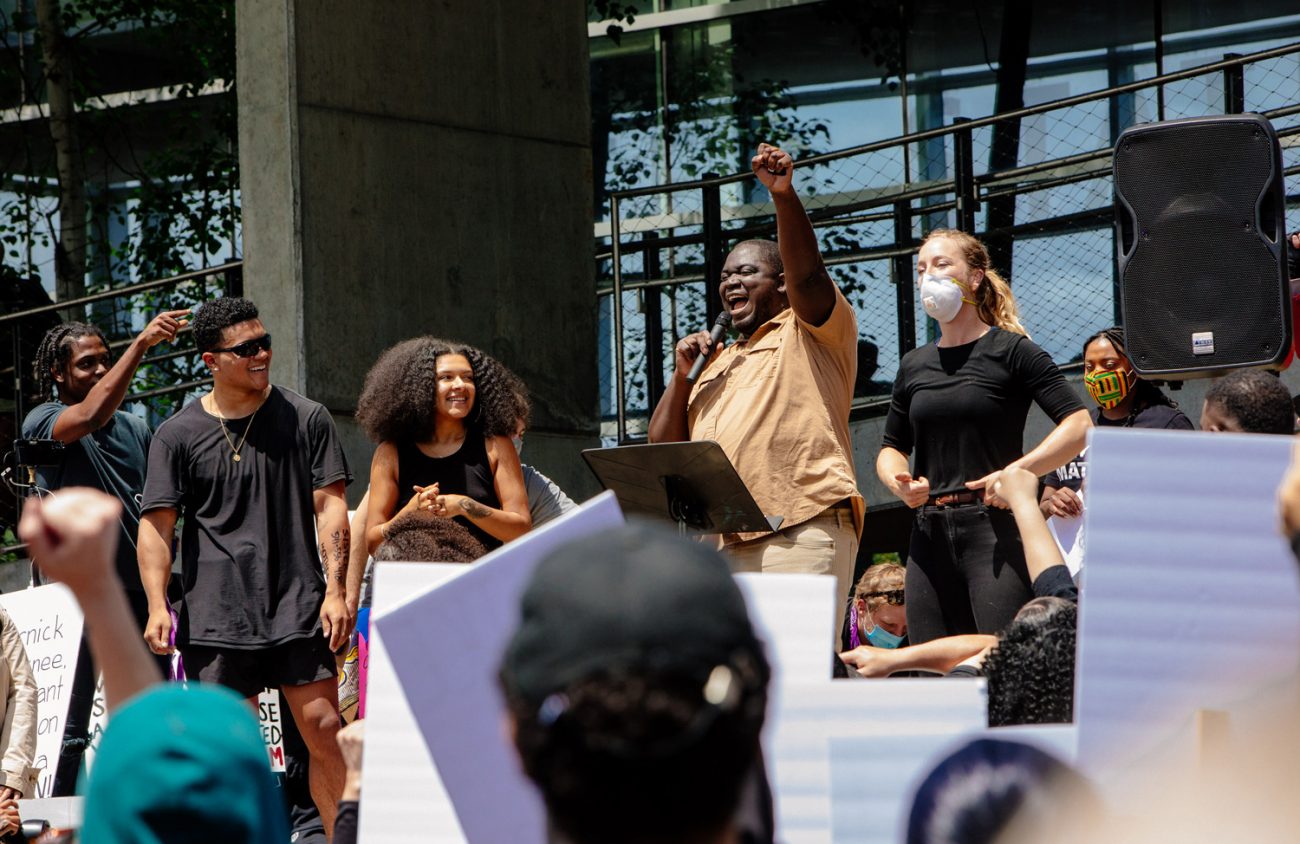With every widely publicized police killing of an unarmed Black person comes nationwide promises to improve policing and suggested reformations to the police system that could make it a safer environment for all people. But in the uprising that has followed the May 25 killing of George Floyd by officers of the Minneapolis Police Department, some people are looking at these past promises and feeling like they’ve been duped.
While the recent Black Lives Matter protests were sparked by Floyd’s murder, they have transformed into a movement against the regular use of lethal police force against Black people in the U.S. That movement has triggered impassioned conversations about the future of policing.
In Eugene, people are having plenty of different conversations about how to go forward. Some make the case for dismantling and abolishing the police force, reallocating the Eugene Police Department’s budget to other services, while others believe that calls for defunding aren’t realistic at this point.
What does it mean to “defund the police”? Groups like the BIPOC Liberation Collective call for abolishing the police force and reallocating its money. Others are inclined toward compromise, hoping to take what they see as more realistic steps to controlling racist police brutality. People who have experience working within or alongside the police system offer insight on the details of police reform and accountability, including how local crisis intervention service CAHOOTS could be a part of a future with less traditional policing. It’s time to expand the notion of what authentic change could look like.
Can Reform Work?
Michael Hames-García is a scholar of criminal justice reform and a professor in the University of Oregon’s ethnic studies department. He finds something unique in the current public conversation about where the future of policing lies.
“What’s happening in the calls for defunding the police is something that has the possibility of actually making an impact in a way that prevents further violence,” Hames-García says.
He says people have been demanding police reform for years, with some popular ideas sticking out — body cams, implicit bias training and hiring for diversity in police departments.
“Police departments resisted them at first, and in recent decades have been more accepting of them. But it doesn’t really change policing,” Hames-Garcia says.
When Michael Brown, an 18-year-old Black man, was shot and killed by Ferguson, Missouri, police officer Darren Wilson in August 2014, protests erupted with people demanding police reforms and accountability.
The Obama administration put together a task force that outlined specific improvements to help police departments rebuild themselves as safe, inclusive and public safety-oriented. The task force came up with six pillars of reformation for police departments to work with, centering on building trust in their communities, training and policy.
In a June 4 column in The New York Times, members of this task force address the failure of police reform. In 2019, according to the Mapping Police Violence project, U.S. police killed 1,098 people, with Black people three times as likely to be killed — and more likely to be unarmed.
“The problem is not that we lack a playbook for fixing police,” the task force members write. “We have one. The problem is that we have not successfully followed the one we have.”
To advocates for solutions that reach beyond police reform, this isn’t the only problem. Sometimes police officers follow the “playbook” just fine — but they still end up killing people.
Minneapolis police officers have been required to wear activated body cameras on emergency scenes since 2018. Despite early stumbles, eventually most officers complied. According to the MPD, the four officers who have been charged with murdering George Floyd were all wearing their body cams. These tools of accountability didn’t prevent an officer from pressing his knee into Floyd’s neck for almost nine minutes, asphyxiating and killing him.
The Eugene Police Department started requiring its officers to wear body cameras in 2017, a year before Police Chief Chris Skinner was appointed.
“The EPD is not foreign to wide sweeping changes and high levels of accountability and oversight,” Skinner says. “Our department stands ready to have these conversations and really lean into this difficult discussion.”
Skinner says he recognizes the broader consequences of systemic racism and how it impacts people’s experiences with police.
“Some of this is a byproduct of a system that has failed individuals for a long time,” Skinner says. “We’re there picking up the pieces of a system that failed these individuals many times along the way.”
But many activists would argue that police reforms just aren’t enough to fix a system that is inherently racist.
Enlarge

Photo by Todd Cooper
Emerging Activists
The Black, Indigenous, People of Color (BIPOC) Liberation Collective is a Eugene-based group that emerged in the wake of recent Black Lives Matter protests.
“Our group came to be following the shared frustration of the local Black Lives Matter leadership being co-opted by pro-cop rhetoric and liberal/moderate ideas that uphold white supremacy in a more insidious way,” members of the BIPOC Liberation Collective write in an email to Eugene Weekly.
The members of the collective say that they wish to remain anonymous for their own safety as vocal anti-racism activists. “Our goal is abolition — a scary word for some,” the email says. “At this moment, we are focusing on abolition of the police force, but abolition holds the ultimate goal of dismantling all systems that perpetuate violence, subjugation and disenfranchisement of Black, Indigenous, and people of Color.”
Members of the collective say that though they share the goal of ending police brutality with other local groups, they will stand firm on their stance on abolition, even if it sets them apart from other local Black Lives Matter activist organizations.
The Black Led Action Coalition (BLAC), is another group working toward police abolition. Spencer Smith, who founded the organization with his sister Madeliene, says he has become more supportive of the abolition movement since the Black Lives Matter protests have started.
The Smiths organized one of the initial anti-racism protests in Eugene on May 31, which brought more than 7,000 people. Initially, they were going to have Chief Skinner speak at the event, but they rescinded their invitation after hearing back from the community.
“After that, we started doing our own research on abolition,” Spencer Smith says. He cites the influential Black activist and philosopher Angela Davis’ book Are Prisons Obsolete? as a foundational text in his understanding of abolition.
Isiah Wagoner is a leader with the Black Unity organization. He says he worries that some of the discussion of defunding or abolishing the police will alienate potential supporters of the Black Lives Matter movement. “I’m big on the baby steps. I don’t believe in saying ‘defund.’ I believe in saying fully fund these other organizations,” Wagoner says. “If you say things like ‘defund the police,’ there will always be a lot of people who don’t know what that means.”
Wagoner wants to see people working together to compromise and make change, even if we don’t see radical results immediately.
“I honestly don’t see people voting to abolish the police departments. How are we going to get to that idea if we don’t come to a compromise?” Wagoner says. “Change has always been slow. It always has been, and it always will be.”
Wagoner sparked controversy among the Eugene protest groups when he made a remark about Black women’s bodies at an early rally that some thought added to the disrespect and objectification that Black women face. Wagoner had spoken about Black women “twerking,” saying if all the Black women at the event turned around and danced, everyone would understand why Black lives matter.
He has since apologized for these comments, saying he hopes to learn from his mistakes. “I will sit back and listen, I’ll educate myself and grow from things,” Wagoner says. “And if something I say is going to divide people, I don’t want to say it.”
On Friday, June 19, the Black Unity group posted a document to Facebook outlining its official demands of Oregon police departments and legislators.
“At this time, Black Unity demands police reform by defunding the police and reallocating these funds to harm-reduction and crisis intervention agencies, community centers and clinics in an effort to reduce reliance on law enforcement officers as first responders. We demand an overhaul of the Oregon criminal justice system by: demilitarizing the police, reducing the amount of police presence in our community, and empowering mental health providers to be the authorizing body for the EPD in crisis situations involving vulnerable populations,” the document says.
The Smiths say that they have distanced themselves from Black Unity because of its stance against police abolition. “We can’t reform the police, and we can’t affiliate with a group who believes in it,” Spencer Smith says.
The Smiths also said that they were troubled by Wagoner’s comments about Black women and the response to them within the Black Unity group, which they thought perpetuated existing sexist behavior against Black women.
Madeliene Smith says she asked Wagoner to leave while the BIPOC Art Collective was painting a Black Lives Matter mural on Friday, June 19, because his previous comments had made people uncomfortable and he was filming the mural painters without their permission.
Apart from in-person protests, some people have found a way to express their views and start public conversations through more unconventional means.
R A Williams, a local abolition advocate, created a Facebook group called “Defund EPD” in early June. It now has more than 650 members who use the platform to discuss ideas about the future of policing in Eugene.
Williams says that the Defund EPD Facebook group is a place for people of all ages and ideologies to cross-pollinate their ideas and explore different visions together. It’s also a space to discuss plans for future protests, and Williams says that they have been able to work with other members of the group to distribute informational material to hand out at the protests, like ‘zines explaining police abolition.
“There’s not really any organizational structure, it’s a group of people working toward a common goal,” Williams says. “There’s no particular ideology or political alignment that is necessary to be involved in discussing this.”
Ricardo Friaz, a UO philosophy graduate student and the chair of the Graduate Teaching Fellows Federation’s BIPOC Caucus, is a member of the Defund EPD Facebook group who advocates for police abolition. He says that he sees this Facebook group as a good place for people to actively think about their role within a racist, overpoliced society, something necessary for moving forward as an activist in the movement.
“It makes you engage and communicate through writing,” Friaz says. “Getting frustrated or hurt feelings is part of the process. It’s not until we get told that we’re wrong and we really feel it that we can step back and look at the problem.”
Change From Within?
Hames-García, the UO professor, is going on his second year as a member of Eugene’s police Civilian Review Board. He says that while Eugene has a fairly robust civilian review process, as well as an independent auditor and active police commission, a lot of this doesn’t make a significant impact on the policing system here.
It is difficult to gather information about what has happened to a police officer once a complaint has been made against them. Information about disciplinary action against police officers is exempt from disclosure under public records law in Oregon.
A 2017 investigation by The Oregonian/OregonLive on state-wide police accountability found that dozens of Oregon police officers who had been fired for misconduct were still eligible to wear a badge and carry a gun. That information, however, was incredibly difficult to access — it took more than two years of intense pushback to even access the misconduct records.
One example of Eugene police misconduct that mainly slipped under the public radar happened in March 2016, when EPD Lt. Doug Mozan allegedly got drunk at a work conference in Bend, flirted inappropriately with a female officer from another department, touching her on her neck, leg and arm, and vomited in front of his colleagues in a police vehicle.
According to a February 2017 Register-Guard article, then-Police Chief Pete Kerns didn’t know about Mozan’s behavior until he was reviewing Mozan’s file for a potential promotion and a supervisor who was present at the time of the incident confessed that he hadn’t reported Mozan earlier. This unnamed supervisor, who had previously worked as an internal affairs investigator, said he didn’t report Mozan because he thought nothing would come of the complaint — like other problems he’d seen go through the internal affairs department before.
Mozan is still employed with EPD, and it is unclear what, if any, disciplinary action was taken against him or the supervisor who failed to report the incident.
Hames-García says such secrecy keeps police officers from real accountability. “The degree of autonomy that police departments have is unprecedented anywhere else in our society,” Hames-García says.
Awab Al-Rawe also served as a member of the Civilian Review Board. His term expired early this month. Al-Rawe has a master’s degree in conflict and dispute resolution from the UO, and he briefly trained as an EPD recruit for the in late 2018 and early 2019, quitting the program after about three months when he realized it wasn’t a good career match.
Al-Rawe, who came to the U.S. as an asylum seeker from Iraq in 2009, says he thought he could be valuable to the police department. He would bring a fresh perspective as the first non-citizen police officer in the department, and with a degree in and passion for conflict resolution, he’d be able to promote nonviolence-based policing strategies.
“That was my naive, young thought,” Al-Rawe says. “As a police recruit and young officer you have no power whatsoever. It’s very difficult to make change as a recruit.”
Though he didn’t feel that he would be able to make change as an individual in the police department as he hoped, Al-Rawe says it was a meaningful experience as someone who is interested in engaging in police accountability work.
“My experience was pretty brief, but I characterize it as valuable,” Al-Rawe says about his time with the EPD. “I got an inside look into the agency. Most people can’t do that, including people on the review board.”
Al-Rawe, who now works as an ombudsperson for the Oregon Health Authority, investigating and resolving complaints from Oregon Health Plan members, says that he still believes that change is possible through more conventional means of engaging with community leaders — as opposed to revolution. He suggests that people interact with the Civilian Review Board and police officials whenever they can.
“Make as many complaints as possible,” Al-Rawe says. “That’s the way things can move forward.”
Enlarge

Photo by Todd Cooper
In CAHOOTS
Eugeneans have a unique tool in our belt with White Bird’s CAHOOTS program. This locally created and run service of White Bird Clinic has been highlighted as a beacon of what community policing could look like on NPR’s “All Things Considered,” in The New York Times, Los Angeles Times and High Country News, all in the past month.
Many people in Eugene are fighting to make it stronger. More than 11,000 people have signed a Change.org petition calling to defund the EPD and reallocate funds to CAHOOTS, which they see as a form of community safety designed to defuse tense situations — no weapons needed.
Chelsea Swift is a crisis worker and EMT with CAHOOTS, which was established in 1989 as a mobile crisis intervention service. She says the program’s holistic de-escalation tactics are vital to its success in the community. “In 30 years, there has never been a serious injury of a CAHOOTS worker, and that is not because we’ve been lucky,” Swift says. “That’s what showing up unarmed does.”
Skinner says that while he thinks the motivation behind the petition is well-meaning, people advocating for significant reallocation of EPD funds to CAHOOTS may be under-informed about the relationship that the two entities have (though CAHOOTS is an acronym for Crisis Assistance Helping Out On The Streets, it’s also a tongue-in-cheek nod to their connection).
“We’ve been singing the praises of the CAHOOTS-EPD relationship for years. It’s just recently that people are starting to listen,” Skinner says.”
Some worry that the relationship is too close for comfort. CAHOOTS can only be reached by calling the local non-emergency police line, where a dispatcher routes calls depending on the perceived need.
Enlarge

Photo by Todd Cooper
CAHOOTS’ Swift says that these are conversations that she and her team are having.
“Everyone calls our clinic and the receptionist has to divert them to the Eugene Police non-emergency line,” she says. “Having a CAHOOTS-designated line has been an ask from the community that we are hearing.”
Swift says that it’s important for CAHOOTS to remain in the 911 system until there are other numbers and services to respond in the field. “If someone is in a crisis in the community, they are not necessarily accessing us per their request,” she says. “A huge portion of calls come from 911, we are a part of those outcomes all the time.”
Swift says that a major component to the CAHOOTS program is how well-established it is in the Eugene community. “When we show up and people see the White Bird clinic logo on our van, they’re seeing what our agency is known for — peace, love, hippie stuff,” Swift says. “There’s not a highly socialized implication about what our showing up means.”
BLAC’s Spencer Smith says he has been working with CAHOOTS for a few months to help provide diversity training for the organization. He says that he appreciates how the team has shown a desire to tackle its own biases before becoming a leader in the movement against racist police brutality. “CAHOOTS is a phenomenal resource, and we fully advocate reallocating funds to their organization,” Smith says. “Of course, the ultimate goal for abolition is communal policing with no need for outside mediators like CAHOOTS, but until then, they should be dispatched on every scene.”
Swift emphasizes the importance of building up other social support systems to supplement the work that CAHOOTS does and reduce the perceived need for police. “I think we satisfy some of the demands of abolition, and can be part of a solution when other areas of improvement show up, too,” she says.
The movement to reallocate EPD funds to White Bird notes that the police department’s proposed FY21 budget is almost $67 million, while CAHOOTS operates on a total of only about $2 million.
Swift says that a budget reallocation would help put more CAHOOTS vans on the road so the organization could attend to more people at once and provide more support staff for the crisis workers and EMTs, which she greatly supports. She says that it’s also important to be able to pay the crisis workers, who work long and demanding shifts, in a fair and sustainable way.
Skinner says he worked to add last year’s nearly $300,000 budget increase for CAHOOTS, which allowed the program to expand its response, adding a second van to operate during peak service hours.
“Part of me advocating for them is based on the recognition that I’d like to get police officers back to doing police work,” Skinner says. “The question for CAHOOTS is to what capacity they can absorb the level of work that they are being expected to do.”
At this time, however, Skinner does not support defunding or divesting the police department.
On Monday, June 22, the Eugene City Council held a hearing to take action on the FY21 budget, in which many members of different anti-racist affiliate groups, including BIPOC Liberation Collective and Black Unity, spoke about their demands for reducing or disposing of EPD’s budget entirely, reallocating the funds to different community programs like CAHOOTS during the meeting’s public forum and the public hearing. The council, however, voted 8-0 in favor of passing the proposed budget, which will not divest money from the EPD.
Imagining the Future
Some activists envision a world without police. Exactly what that means is yet to be seen and hard to predict.
Swift says she is excited by the requests people are making for CAHOOTS and thinks that the energy will be able to create change in the program and in the community. “At a certain point, we may be asked to do radical things that we didn’t think were possible before,” she says.
When envisioning a future without police, members of the BIPOC Liberation Collective say that they want to be clear that their vision of abolition isn’t complete chaos, but rather a restructuring of society so policing isn’t seen as a required way to maintain order.
Members of the collective say that their goal for abolition isn’t to replace the police with organizations that will serve the same purpose, instead hoping for social conditions that keep people safe and healthy in a holistic way. “What we aspire to is the creation of a community in which the base needs of all members are met,” they write.
Madeliene and Spencer Smith of BLAC say that they will be working to organize more events to teach people how to think radically. “The whole point of police abolition is not to imagine a world where we don’t have police, but a world where we don’t need police,” Spencer Smith says. “When everybody has the services and support they need, that will be the foundation.”
Friaz, the UO philosophy graduate student, stresses the importance of being able to envision a seemingly radical anti-racist future, where everybody’s needs are met, as a part of making it happen. “My source of hope is in this commitment to imagining a better world together. The way oppressive structures have been upheld is to say it doesn’t get any better than this,” Friaz says.
“We’re gonna cure cancer, we went to the moon and built fast cars and shit,” he says. “It’s ultimately a matter of getting people to imagine a new world in a way that we’ve only done with technology up until this point.”
